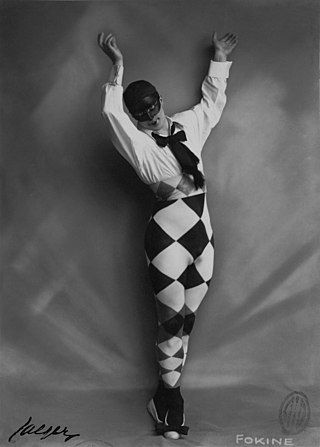
Sergei Pavlovich Diaghilev, also known as Serge Diaghilev, was a Russian art critic, patron, ballet impresario and founder of the Ballets Russes, from which many famous dancers and choreographers would arise.

Vaslav or Vatslav Nijinsky was a Russian ballet dancer and choreographer of Polish ancestry. He is regarded as the greatest male dancer of the early 20th century.

Vorticism was a London-based modernist art movement formed in 1914 by the writer and artist Wyndham Lewis. The movement was partially inspired by Cubism and was introduced to the public by means of the publication of the Vorticist manifesto in Blast magazine. Familiar forms of representational art were rejected in favour of a geometric style that tended towards a hard-edged abstraction. Lewis proved unable to harness the talents of his disparate group of avant-garde artists; however, for a brief period Vorticism proved to be an exciting intervention and an artistic riposte to Marinetti's Futurism and the Post-Impressionism of Roger Fry's Omega Workshops.

David Garshen Bomberg was a British painter, and one of the Whitechapel Boys.

Michael Fokine was a Russian choreographer and dancer.

Blast was the short-lived literary magazine of the Vorticist movement in Britain. Two editions were published: the first on 2 July 1914 and featured a bright pink cover, referred to by Ezra Pound as the "great MAGENTA cover'd opusculus"; and the second a year later on 15 July 1915. Both editions were written primarily by Wyndham Lewis. The magazine is emblematic of the modern art movement in England, and recognised as a seminal text of pre-war 20th-century modernism. The magazine originally cost 2/6.

William Patrick Roberts was a British artist.

Léon Bakst, born Leyb-Khaim Izrailevich Rosenberg, was a Russian painter and scene and costume designer of Jewish origin. He was a member of the Sergei Diaghilev circle and the Ballets Russes, for which he designed exotic, richly coloured sets and costumes. He designed the décor for such productions as Carnaval (1910), Spectre de la rose (1911), Daphnis and Chloe (1912), The Sleeping Princess (1921) and others.

Natalia Sergeevna Goncharova was a Russian avant-garde artist, painter, costume designer, writer, illustrator, and set designer. Goncharova's lifelong partner was fellow Russian avant-garde artist Mikhail Larionov. She was a founding member of both the Jack of Diamonds (1909–1911), Moscow's first radical independent exhibiting group, the more radical Donkey's Tail (1912–1913), and with Larionov invented Rayonism (1912–1914). She was also a member of the German-based art movement Der Blaue Reiter. Born in Russia, she moved to Paris in 1921 and lived there until her death.

Edward Alexander Wadsworth was a British artist initially associated with the Vorticism movement. In the First World War he was part of a team involved in the transfer of dazzle camouflage designs to ships for the Royal Navy. After the war his maritime landscapes and still-life compositions using tempera were infused with a surrealistic mood - although he never exhibited with the British surrealists. In the early thirties and in the early forties his work was mainly abstract. He made a significant contribution to the development of modern art in Britain in the inter-war years.

Helen Saunders was an English painter associated with the Vorticist movement.

Dame Laura Knight was an English artist who worked in oils, watercolours, etching, engraving and drypoint. Knight was a painter in the figurative, realist tradition, who embraced English Impressionism. In her long career, Knight was among the most successful and popular painters in Britain. Her success in the male-dominated British art establishment paved the way for greater status and recognition for female artists.

The Ballets Russes was an itinerant ballet company begun in Paris that performed between 1909 and 1929 throughout Europe and on tours to North and South America. The company never performed in Russia, where the Revolution disrupted society. After its initial Paris season, the company had no formal ties there.

Jacob Kramer was a Russian Empire-born painter who spent all of his working life in England.

Léopold Frédéric Léopoldowitsch Survage was a Russian-French painter of Finnish origin. Trained in Moscow, he identified with the Russian avant-garde before moving to Paris, where he shared a studio with Amedeo Modigliani and experimented with abstract films. He also gained commissions for Serge Diaghilev's Ballets Russes.

The Mud Bath is a 1914 oil-on-canvas painting by David Bomberg. The work is considered a masterpiece of Bomberg's work in this period. Bomberg was a founder member of the London Group, and the painting is considered a leading example of Vorticism, although Bomberg resisted being described as a Vorticist.

Lilian Thirza Charlotte Holt (1898–1983) was a British artist, also known by her married name, Bomberg. She was a founding member of the Borough Group. Her dedication to her partner and family limited her career and opportunities as an artist.

Horace Ascher Brodzky was an Australian-born artist and writer most of whose work was created in London and New York. His work included paintings, drawings and linocuts, of which he was an early pioneer. An associate in his early career of many leading artists working in the Britain of his period, including Henri Gaudier-Brzeska, Mark Gertler, and members of the Vorticism movement, he ended his life relatively neglected.
Henderson's, better known as The Bomb Shop, was a bookshop at 66 Charing Cross Road, London known for publishing and selling both radical left and anarchist writing and modernist literature. The shop was founded in 1909, and was a father and son operation run by Francis Riddell Henderson, formerly the London representative of Walter Scott Publishing. The shop was bought by Eva Collet Reckitt, and became the first of the Collet's chain of left-wing bookshops.
The Chenil Gallery was a British art gallery and sometime-music studio in Chelsea, London between 1905 and 1927, and later the location of various businesses referencing this early use.



















